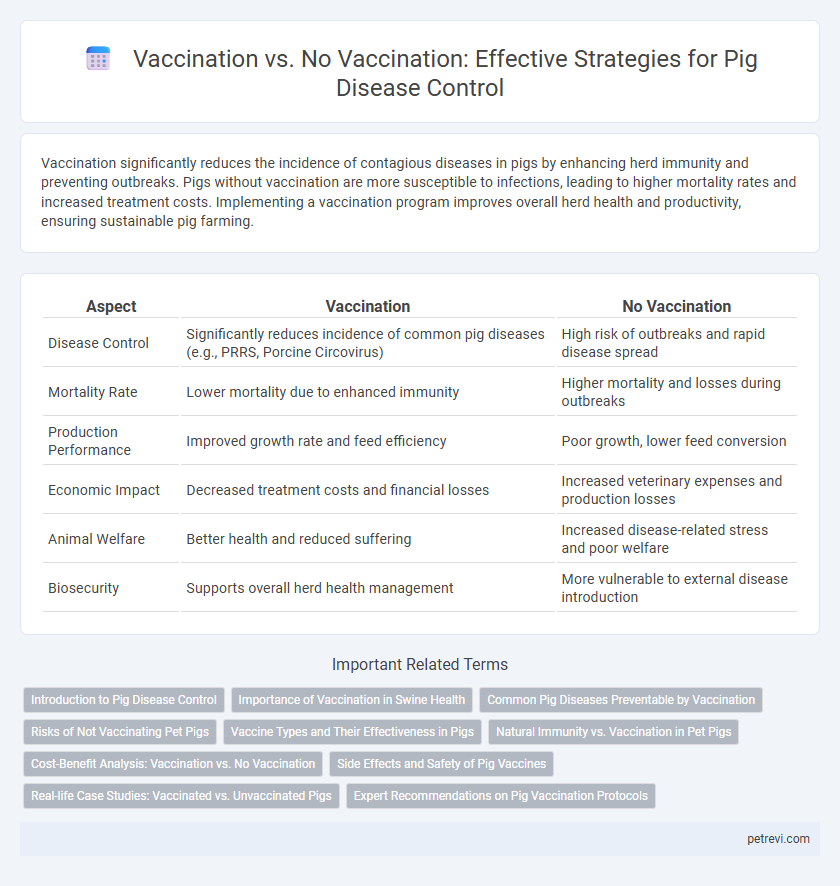Vaccination significantly reduces the incidence of contagious diseases in pigs by enhancing herd immunity and preventing outbreaks. Pigs without vaccination are more susceptible to infections, leading to higher mortality rates and increased treatment costs. Implementing a vaccination program improves overall herd health and productivity, ensuring sustainable pig farming.
Table of Comparison
| Aspect | Vaccination | No Vaccination |
|---|---|---|
| Disease Control | Significantly reduces incidence of common pig diseases (e.g., PRRS, Porcine Circovirus) | High risk of outbreaks and rapid disease spread |
| Mortality Rate | Lower mortality due to enhanced immunity | Higher mortality and losses during outbreaks |
| Production Performance | Improved growth rate and feed efficiency | Poor growth, lower feed conversion |
| Economic Impact | Decreased treatment costs and financial losses | Increased veterinary expenses and production losses |
| Animal Welfare | Better health and reduced suffering | Increased disease-related stress and poor welfare |
| Biosecurity | Supports overall herd health management | More vulnerable to external disease introduction |
Introduction to Pig Disease Control
Vaccination is a critical component in pig disease control, significantly reducing the incidence of illnesses such as Porcine Reproductive and Respiratory Syndrome (PRRS) and Classical Swine Fever (CSF). Pigs without vaccination remain highly vulnerable to outbreaks, leading to increased mortality rates and economic losses in swine production. Effective disease control programs combine vaccination with biosecurity measures to maintain herd health and optimize productivity.
Importance of Vaccination in Swine Health
Vaccination in swine health significantly reduces the incidence of contagious diseases such as Porcine Reproductive and Respiratory Syndrome (PRRS) and Swine Influenza, leading to improved herd immunity and reduced mortality rates. Vaccinated pigs demonstrate enhanced growth performance and reproductive efficiency compared to non-vaccinated populations, directly benefiting farm productivity. Implementing comprehensive vaccination protocols is critical for controlling outbreaks, minimizing economic losses, and ensuring biosecurity in pig farming operations.
Common Pig Diseases Preventable by Vaccination
Vaccination effectively prevents common pig diseases such as Porcine Circovirus Associated Disease (PCVAD), Swine Influenza, and Classical Swine Fever, significantly reducing mortality rates and improving herd immunity. In contrast, pigs without vaccination remain highly susceptible to outbreaks, leading to severe economic losses and increased antibiotic use. Implementing a comprehensive vaccination program ensures better disease control, enhances growth performance, and reduces the risk of zoonotic transmission.
Risks of Not Vaccinating Pet Pigs
Not vaccinating pet pigs significantly increases the risk of outbreaks of infectious diseases such as Porcine Reproductive and Respiratory Syndrome (PRRS) and swine influenza, which can lead to severe respiratory issues, reproductive failure, and increased mortality rates. The absence of vaccination leaves pigs vulnerable to rapid disease spread within populations, causing economic losses and potential zoonotic transmission. Unvaccinated pigs also contribute to antimicrobial resistance through increased use of antibiotics to treat preventable infections.
Vaccine Types and Their Effectiveness in Pigs
Live attenuated vaccines and inactivated vaccines are the primary types used for pig disease control, each offering distinct immune responses and protection levels. Live attenuated vaccines induce stronger and longer-lasting immunity by mimicking natural infection, while inactivated vaccines provide safer alternatives with reduced risk of adverse effects but often require booster doses. Effectiveness varies by disease; for example, live vaccines are highly effective against classical swine fever, whereas inactivated vaccines are preferred for porcine reproductive and respiratory syndrome due to safety concerns.
Natural Immunity vs. Vaccination in Pet Pigs
Natural immunity in pet pigs develops through controlled exposure to pathogens, often resulting in broader immune response but carries risks of severe illness and death. Vaccination provides targeted protection by stimulating specific antibodies against diseases like Porcine Circovirus and PRRS, reducing morbidity and mortality rates significantly. Combining vaccination with proper husbandry practices ensures optimal health management and minimizes reliance on natural exposure, which can compromise pig welfare.
Cost-Benefit Analysis: Vaccination vs. No Vaccination
Vaccination in pigs significantly reduces the incidence and severity of infectious diseases such as Porcine Reproductive and Respiratory Syndrome (PRRS) and Swine Influenza, leading to improved herd health and productivity. Cost-benefit analysis reveals that the initial investment in vaccines results in lower veterinary expenses, reduced mortality rates, and enhanced growth performance, which outweighs the vaccination costs. In contrast, opting for no vaccination can incur higher financial losses due to increased disease outbreaks, treatment costs, and diminished market value of affected pigs.
Side Effects and Safety of Pig Vaccines
Pig vaccines demonstrate a strong safety profile with minimal side effects, typically limited to mild local reactions such as swelling or transient fever. In contrast, pigs without vaccination are at higher risk of severe infectious diseases, leading to increased mortality and economic losses in swine production. Reliable vaccination protocols reduce disease prevalence while maintaining animal welfare through controlled adverse reactions.
Real-life Case Studies: Vaccinated vs. Unvaccinated Pigs
Vaccinated pigs in real-life case studies demonstrate significantly lower morbidity and mortality rates compared to unvaccinated groups, highlighting the effectiveness of vaccines in controlling diseases such as Porcine Reproductive and Respiratory Syndrome (PRRS) and Swine Influenza. Data from multiple farms reveal that vaccination reduces viral load and clinical symptoms, leading to improved growth performance and economic returns. Unvaccinated pigs frequently experience higher incidence of outbreaks, increased antibiotic use, and greater financial losses due to disease-related complications.
Expert Recommendations on Pig Vaccination Protocols
Expert recommendations emphasize that pig vaccination protocols significantly reduce the incidence of common swine diseases such as Porcine Reproductive and Respiratory Syndrome (PRRS) and Swine Influenza. Studies demonstrate that vaccinated herds exhibit improved weight gain, lower mortality rates, and reduced antibiotic usage compared to non-vaccinated populations. Implementing tailored vaccination schedules based on herd health status ensures optimal immune protection and enhances overall production efficiency.
Vaccination vs No vaccination for Pig disease control Infographic

 petrevi.com
petrevi.com